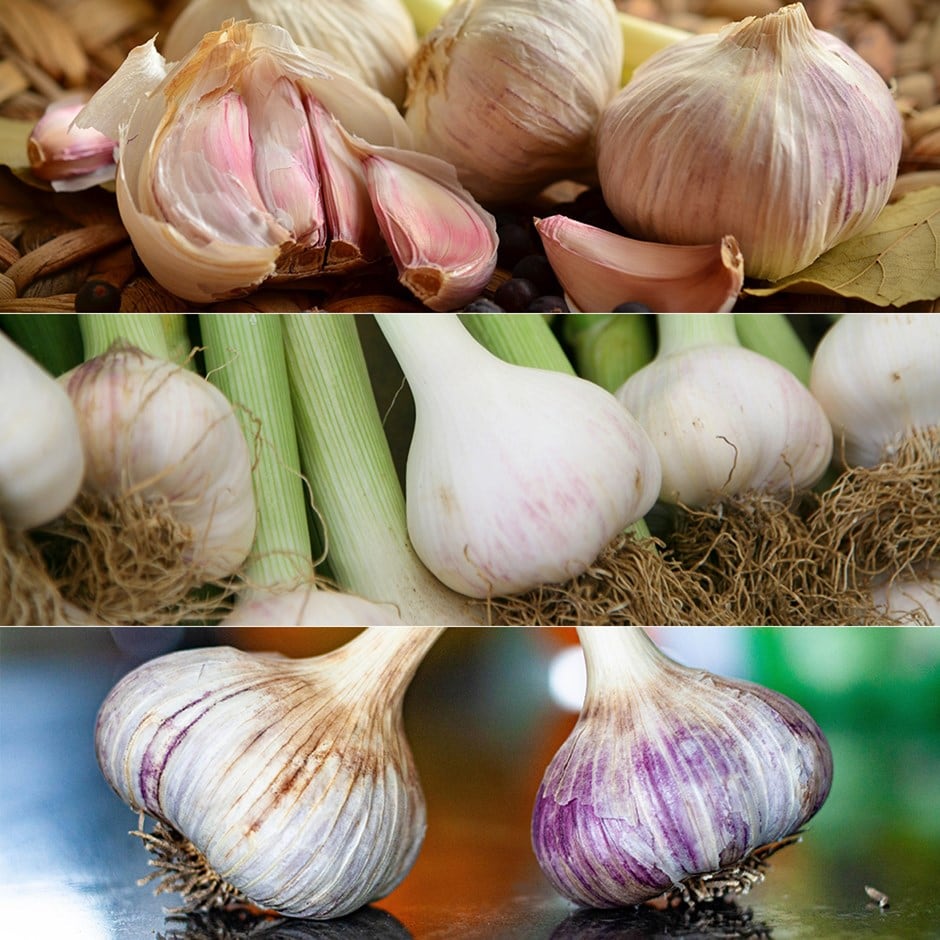Connoisseurs garlic collection for autumn planting
garlic collection
- 1 × collection | 3 heads/bulbs
- £14.95 £4.98 each
- Delivered during October
- 2 × collections | 6 heads/bulbs
- £19.95 £3.33 each
- Delivered during October
Delivery options
- Bulbs (only) £4.99
- Position: full sun
- Soil: moderately fertile, moist, well-drained soil
- Rate of growth: average
- Hardiness: fully hardy
Closely related to onions and leeks, garlic is used to add flavour to many savoury dishes. It has also been widely used for its health benefits, which are said to include reducing blood pressure, cleansing the blood and even giving the immune system a natural boost.
This collection contains both softneck and hardneck cultivated varieties.
This collection contains both softneck and hardneck cultivated varieties.
Each collection contains one head (or bulb) of each of the garlics below, and each head can be split up into several cloves before planting.
garlic 'Carcassonne Wight': Vigorous, reliable and well-suited to UK growing conditions, this hardneck garlic produces attractive pink cloves with excellent flavour and aroma. It performs especially well in cooler, temperate climates and is known for its strong, aromatic character and consistent bulb formation. It forms 8-12 well-sized cloves per bulb, typically ready to harvest in June or July from autumn plantings. Expect good skin cover and a robust taste profile, ideal for cooking or drying.
garlic 'Rhapsody Wight': Bursting with purple pride, ‘Rhapsody Wight’ is the earliest softneck variety ready to harvest. Planted in autumn, this vivid garlic springs forth in a spectacular early summer style with the bulb's brilliant purple streaks and mottling visible as it pushes itself from the earth. Expect to uncover 5-12 large easy-to-peel cloves tucked within each showy wrapper. Beyond its visual bravado, this garlic tempts the taste buds with a fresh and lively flavour, adding punch and personality to soups, sauces, roasts or any dish in need of a little flair.
garlic 'Kingsland Wight': A garlic that embodies versatility and flavour, that is reliable in colder, more northerly regions of the UK. This hardneck variety with its regal ties was first cultivated near Toulouse in southern France, bringing old world charm to modern gardens. Planted in autumn or early spring, a long growing season allows the full flavour to develop before harvest in September. Unlike other hardneck varieties, ‘Kingsland Wight’ offers an abundance of large easy-to-peel cloves tucked within each papery sheath. Its rich, nuanced flavour elevates soups, sauces, roasts or anything needing a boost.
When planting a garlic collection that includes both hardneck and softneck types, choose a sunny, open site with free-draining soil, ideally enriched with compost or well-rotted manure beforehand.
Plant individual cloves upright and pointed end up, around 15cm (6in) apart and 3-5cm (1-2in) deep, spacing rows around 30cm (12in) apart. Hardneck varieties tend to be hardier and may benefit from autumn planting, while softnecks are often more flexible and can be planted in autumn or early spring depending on your region.
Keep the area weed-free and water during dry spells in spring. As hardnecks often produce flower stems (called scapes), remove these promptly to direct energy into bulb formation.
Begin reducing water in early summer once leaves start to yellow, and harvest when most of the lower leaves have died back. Lift carefully and cure bulbs by drying them in a well-ventilated, shaded spot for 2-3 weeks. Once fully dry, trim roots and stems and store in a cool, dry place.
Plant individual cloves upright and pointed end up, around 15cm (6in) apart and 3-5cm (1-2in) deep, spacing rows around 30cm (12in) apart. Hardneck varieties tend to be hardier and may benefit from autumn planting, while softnecks are often more flexible and can be planted in autumn or early spring depending on your region.
Keep the area weed-free and water during dry spells in spring. As hardnecks often produce flower stems (called scapes), remove these promptly to direct energy into bulb formation.
Begin reducing water in early summer once leaves start to yellow, and harvest when most of the lower leaves have died back. Lift carefully and cure bulbs by drying them in a well-ventilated, shaded spot for 2-3 weeks. Once fully dry, trim roots and stems and store in a cool, dry place.
- Pets: TOXIC if eaten; Humans: Skin irritant/allergen

